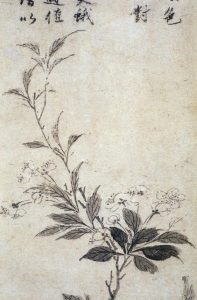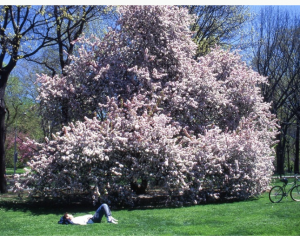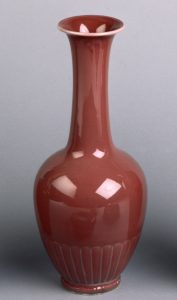
Zhou, Shen. Flowering Crabapple. 1427-1509.
Crabapple
Introduction
Crabapples are covered in beautiful pink flowers, often featured in many Chinese gardens. Flowering in the springtime and bearing fruit in the summer and fall. It is a beautiful yet useful plant to have in your garden.
Where are they produced
There are many different types of crabapple trees that live on every continent except Antarctica. They originated in, “the mountainous regions of Central Asia, specifically in modern day Kazakhstan. They became popular cultivars (trees used for selective breeding) and spread throughout the continent via the Silk Road Romans brought the species from Asia into Europe,” (DuBois). Crabapples in China also have many different characteristics, “They vary in flower color, fruit color, and for their variability of tree shape, from weeping and spreading types to rounded and columnar forms.” (Chatfeild). They prefer to grow in easily drained soil and can grow in heavy clay soil. It can also grow in shaded and non-shaded areas. It is, “An easily grown plant, it succeeds in most fertile soils, preferring a moisture retentive well-drained loamy soil” and is ,” A very “ornamental tree” (Aiton).
Miller, Sara Cedar. Central Park East Green. Foundation for Landscape Studies, Central Park Conservancy, Central Park, New York, New York, United States.
Uses
Crabapple trees have many uses. The fruit the tree bears can be eaten by humans and animals, “Because of their sour taste, crabapples are usually not eaten raw by humans; they are sometimes used as condiments Often used for cooking flames for smoked foods, crabapple wood releases a pleasant aroma while burning very slowly.” (DuBois). Crabapples are also used for medicinal purposes, “specifically to neutralize the acidic effects of gout and indigestion.” (DuBois). The flowers are used to make a dye for clothing and pottery (see figure 1). They are most commonly used for decorations on patios, in gardens, or lining streets and, “are widely grown for their attractive growth habit, spring flower display, and decorative fruit,” (DuBois).

Figure 1: Lotus petal vase, 1710-1722, crabapple glaze, Walters art museum
Artistic Significance
Crabapple trees have been painted in many garden scenes, their flowery display made them one of the more popular flowering trees to paint including; peach blossoms, plum blossoms, and other flowering trees. They, “are especially revered in China, where they anchor locations such as the Summer Palace outside Beijing, where in combination with peonies symbolize honor, health, and distinction.” (Chatfeild).
Environmental Issues
Like other plant life, crabapple trees help to prevent erosion of soil and rocks. Crabapple trees as well as other trees do a better job at preventing erosion than other plants do, due to their deeper root systems. Crabapple trees also act as a natural filter for water to filter out the toxins before the water reaches streams and rivers. These trees also produce fruit that humans and animals can consume, “The fruit is a good wildlife food source, especially for birds” (Aiton). Crabapple trees also provide shelter for birds as well as food.
Questions
- Why would someone plant a crabapple tree in their garden?
- What additional uses could you use crabapple trees for in your daily life?
- How do you think crabapple trees could have been used in ancient China?
Citations
- Chatfeild, Jim, and Erik Draper. “Crabapples in China.” Buckeye Yard and Garden Online. April 26, 2017. Accessed July 11, 2018. https://bygl.osu.edu/index.php/node/717.
- “Malus Spectabilis – (Aiton.)Borkh.” Pfaf Plant Search. Accessed July 12, 2018. https://pfaf.org/user/Plant.aspx?LatinName=Malus spectabilis.
- Reynolds, Nathaniel D., and Christine Dupres. “The Pacific Crabapple (Malus fusca) and Cowlitz Cultural Resurgence.” Journal of Northwest Anthropology 52, no. 1 (2018).



